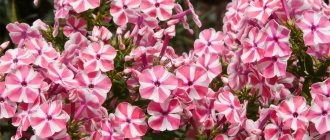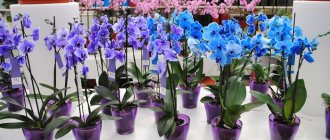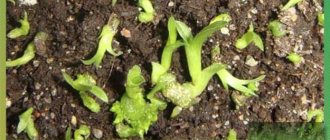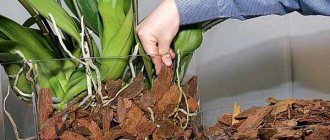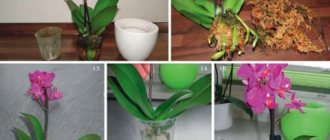Author: Elena N. https://floristics.info/ru/index.php?option=com_contact&view=contact&id=19 Category: Houseplants Published: May 23, 2012Republished: February 22, 2019Last edits: March 16, 2021
For the first time I saw indoor orchids from a friend. The family lives prosperously, they have a spacious house with large windows, and on every windowsill there are flowerpots with orchids. The owner's story disappointed me because orchids are not a cheap pleasure. But from that very day I had a dream to collect a collection of orchids in my modest apartment. And then the dream began to come true: for my anniversary, the children gave me a luxurious orchid. I was in seventh heaven.
Species suitable for cultivation
Unfortunately, not all species of this family are suitable for cultivation at home, being delicate and sensitive to the growing climate zone, which plays a crucial role when choosing a pet. Therefore, from the entire variety of orchids, it is worth choosing those whose cultivation will not be associated with special conditions, the creation of which is simply impossible at home.
One of the best species is Phalaenopsis . It blooms for a long time and beautifully, for which it is highly valued by gardeners. It pleases with a variety of shades and fits well into the interior of apartments.
Also a good choice would be the Cattleya orchid, known for its aerial roots, the Vanda orchid, whose large flowers become increasingly brighter in color over time, the Dendrobium, which pleases the eye with its monthly flowering, and the Zygopelatum, which amazes with its multicolored petals and exquisite aroma.
Orchid roots - what are their features
The structural features of the orchid root system are due to the fact that this organ performs many important functions.
Firstly, with the help of roots, orchids are attached to the substrate, which allows them to maintain a vertical position. Secondly, the roots actively participate in photosynthesis, sharing this function with the leaves. Thirdly, with the help of the root system, orchids absorb moisture and nutrients from the air and the bark of the plants on which they live.
Roots are main and adventitious. The latter are formed on any part of the plant except the root itself. In orchids of the monopodial type, adventitious roots are formed on the stems, while in the sympodial type, adventitious roots are formed on the rhizomatous sections of the shoots. To receive the required amount of nutrients, the root system of the epiphyte must be well developed. That’s why many orchids grow a whole “beard” of aerial roots.
For many plants, roots that have grown outside the pot are a signal to transplant into a larger container. With orchids it’s the other way around: adventitious roots are a sign that the orchid has taken root successfully and is feeling good.
The structure of the orchid root is interesting in that the roots are covered with velamen - a white coating, a special tissue made of dead cells filled with air.
With the help of such a “sponge”, the roots store moisture for the dry period. Therefore, the longer the drought in the place where the orchid grows, the thicker the velamen layer will be. This fabric also protects the roots from damage.
Growing methods
The methods of growing orchids are very diverse, but each of them is unique in its details and stages. The secrets of the life cycles of their favorite plants are revealed before the eyes of professional gardeners, amateurs and beauty connoisseurs. Let's look at some of them.
You can get a full-fledged plant from seeds only by using special media (for example, agar-agar), which are sold in specialized stores. Following the instructions, the seeds are planted and the conditions are monitored. If everything is done correctly, the result will be positive (read more about how to grow an orchid from seeds).
Important! The seeds are planted in sealed jars and they germinate only after 9 months.
You can also get an orchid from bulbs, also called bulbs. Pseudobulbs are cut off from them and planted in moss, having previously been rubbed with coal.
Another way is to grow from shoots. As soon as its length reaches at least 3 centimeters, it is cut off with a disinfected tool and wrapped in damp moss. When, after their appearance, the roots grow to 5 centimeters, it will be possible to strengthen the young plant on the substrate.
Substrate compositions for different types of orchids
photo from ajoya.com
There are many types of orchids, and each has its own requirements for the soil in which they will grow. There are an abundance of substrates for these flowers on sale, but so far none of them fully meets their needs. Therefore, gardeners often add the necessary components to the purchased substrate or prepare it themselves.
So, phalaenopsis can be planted either in pine bark alone or in a mixture with it. For example, bark and sphagnum moss, which is laid on top, bark and charcoal (5:1), bark, sphagnum moss and charcoal (5:2:1), bark, sphagnum moss, fern roots and expanded clay (5 :2:2:1).
For cattleya, a substrate made of pine bark, sphagnum moss (it can be replaced with coconut fiber) and charcoal (5:3:2) is suitable. For miltonia, mix fine pine bark, high peat, sphagnum moss and charcoal in equal proportions.
Vanda, like dendrobium, grows well in pine bark, but in dry air you can put sphagnum moss on top and spray it periodically.
- Which orchid to choose for a beginner - advantages and disadvantages of popular types
Plunge into the luxurious world of orchids and choose a new tenant for your home or winter garden!
Preparation for cultivation
In order to grow an orchid at home, you should thoroughly prepare for this, since only special conditions, thoughtfully and painstakingly created, will lead to success.
Capacity.
This is the first thing you need to prepare. It should be taken into account that orchids grow poorly or not at all in an ordinary pot, which means they need special vessels. All over the world, three options for containers for growing orchids at home are preferred:
- Transparent plastic containers with holes on the sides and bottom for free air access to the roots.
- Clay pots. Drainage and substrate composition will be important here. Not all types of orchids are ready to grow in such pots.
- Wicker baskets. They themselves are ready for good aeration; also, their ease and convenience speak in their favor.
Priming
Soil for orchids is qualitatively different from simple garden soil, so its choice should be approached with skill and care. The life of the flower, its development and ability to reproduce will depend on its quality.
Important! Properly selected soil provides oxygen supply and removes excess moisture from the roots, which avoids rotting.
Beginners should purchase a ready-made mixture. Ready-made substrates are sold in specialized stores. Experienced gardeners will find it easy to make their own soil. The following fillers are suitable for this:
- Peat
- Tree bark
- Coarse sand
- Sphagnum moss
- Charcoal
Their ratio may be approximately the same.
Important! The moss should be placed on top of the substrate to retain a small amount of moisture.
The starting materials must be crushed and well dried. A special role is played by the drainage system, which should occupy from 3 centimeters to a third of the entire container. When using a basket, drainage is not always required.
Replanting a home orchid
Replanting an orchid is not as complicated a process as it seems to novice gardeners, but it still has rules and you need to know them. An orchid is replanted when the previous pot becomes small or when the substrate is “eaten” by the plant. Half an hour before transplanting the orchid into a new pot, you need to water it well so that the roots can be removed from the pot more easily. Then you need to crush the plastic pot a little in your hands so that the lump of earth with roots is easier to remove. Insert a knife into a clay pot between the earthen lump and the wall and move it so that the earthen lump easily comes out of the container.
Then try to remove the old substrate from the orchid’s roots: to do this, just shake off what crumbles on its own; the remaining substrate will help the orchid adapt more quickly to the new soil. Now, using a sharp sterile instrument, remove dead, rotten and damaged roots, and treat the cut areas with charcoal powder. Take a pot with large drainage holes, put a few large pebbles in it for counterweight, add drainage, a little coarse bark, then lower the orchid roots into the pot, carefully straighten them and cover with substrate on top, distributing it evenly in the pot.
You can water the transplanted orchid the next day if the substrate has already dried out by then.
Temperature
It will be optimal to keep the flower at 20-28 degrees. Orchids at home prefer a clear boundary between day and night temperatures. The difference should almost always range from 5 to 7 degrees. In order to stimulate flowering, it is worth reducing the temperature to 12-17 degrees.
Important. Exposing a flower to low temperatures is unsafe and even fatal.
Lighting
Growing and care require compliance with the light regime for this beautiful flower, which primarily concerns the location. The south and southeast sides are the most convenient and favorable for orchids. It is important to remember that direct sunlight can greatly dry out your pet, so a translucent filter or light shade is recommended.
Side lighting is also considered very suitable for successfully growing orchids, although this is more difficult at home than in a greenhouse. If there is not enough light, you need to take care of an additional source.
Watering
In principle, home care allows the orchid to survive without water for up to 2 weeks. But, most often, the watering regime in the warm season is once every 3 days, in the cold season – once a week. For delicate tropical creatures, use filtered, rain, boiled warm water. Under no circumstances should water stagnate in the container.
Particular attention should be paid to the manner of watering, since this must be done, trying not to touch the flower or get into the inflorescences. Or immersion in water is carried out for a period of up to half an hour.
Important! The plant can be sprayed, but moisture should not get on the inflorescences. If this cannot be avoided, they need to be wiped.
Feeding
Liquid fertilizers are used once every 3-4 weeks. Fertilizers containing nitrogen are excellent. Active growth and flowering are ensured by systematic nutrient application procedures. Fertilization processes should be activated during the active phases, and when growth stops, stop, resuming when the peduncle is activated. Next, feeding can be suspended and the breeding process can begin.
Care after flowering
After flowering, trim the flower stem at its base, with the exception of phalaenopsis, which may bloom several times. Its peduncle is cut off at the level of the second or third thickening from the growth point, when it finally fades. Then place the plant in a cool place, maintaining the minimum temperature depending on the species. Reduce the number of waterings; the surface of the substrate should be dry at a depth of 1-2 cm. Do not fertilize the flower until new shoots appear.
To care for orchids you will need:
- a watering can with a long thin spout, so as not to flood the young shoots with water during watering. To do this, place the spout of the watering can away from the plant, watering only the substrate around it. There is another method of watering, which has already been mentioned - place the pot completely in water, leave for half an hour, and then let the excess water drain. This method is more suitable for orchids in the substrate and allows you to saturate it with water as much as possible;
- sharp pruning shears for cutting stems and dried leaves. Heat the blades over a fire or disinfect them with alcohol after each use;
- spray. It is better to choose spray bottles with the ability to adjust the pressure level.
Reproduction
There are many ways to propagate indoor flowers. The most suitable method for orchids is cuttings.
To achieve a positive result, you need to bring the flower into comparative balance. For example, after the end of the flowering phase, you can quarantine (about 30 days), observing stable temperature and light conditions. Then, using a sterile instrument, cut the shoot up to 15 centimeters in length and lay it on the substrate. An excellent solution would be to create greenhouse conditions.
Such conditions are easily created using a plastic container and cling film, of course, at a constant temperature of at least 25 degrees; after the roots appear, the sprouts can be transplanted into a pot. It is also important to comply with the drainage height conditions to allow for aeration and removal of excess moisture.
In this article we described how to grow an orchid at home. Detailed information on each type can be found in separate articles.
Orchid leaves, their functions and features
From the leaves you can immediately understand how successfully the plants adapt to environmental conditions. For example, specimens that grow in arid regions (Aerangis) have thick, dense and elastic leaf blades, like many succulents. Flowers growing in open and well-lit areas also have thick leaves. And in shade-loving orchids (miltonia), the greenery is most often soft and light, and can turn yellow or burn in the sun.
The structure of an orchid leaf allows the leaf blades not only to participate in photosynthesis, but also to maintain water balance (for example, by evaporating moisture) and receive nutrients. All this is possible thanks to venation. Veins are vascular-type tissue in the spongy mesophyll layer. In some types of orchids, the “vascular” system consists of xylem, the tissue responsible for moving water throughout the plant, as well as phloem, the tissue that transports nutrients.
Most often, the leaves of orchids are green, but variegated varieties are also found. By the way, there are also representatives of the family that are grown not so much for the flowers, but for the original color of the leaf blades. Such original specimens include the so-called “precious” orchids:
- anectochilus,
- gemaria,
- goodyear,
- dossinia,
- macodes,
- Cheirostylis.
First confirmed mention of orchids
Scientists considered the orchid family to be almost the youngest among flowering plants. For some time. There were many hypotheses. But a piece of amber approximately 15-20 million years old with a bee has changed many ideas. On the chest of this bee there was a pollinarium as evidence. This is where orchid pollen develops:
- Scientists now agree that orchids are approximately 130 million years old. And at 65 million years they were already divided into five lines. These lineages correspond to the current subfamilies. These are the differences. Plus or minus ten million years;
- But actually about their existence was first recorded in China. The designs and hieroglyphs used were depicted sometime around 500 BC:
Artists painted Coelogina and Cymbidium ; - And in writing . Hieroglyphs have been used for more than 2500 years: Lan - orchid;
- Tin Lan - heavenly orchid;
- Lan Fong – orchid scent;
- Yeuk Lan – looks like an orchid.
- His works on botany “History of Plants” (Historia plantarum), “Causes of Plants” (De causis plantarum) are still known. They mention the word orchis. And in ancient Greek it means Orchis (testicle);
- Another Greek scientist, Dioscrides, also could not ignore orchids in his works;
- In China, orchids were taken seriously . From the 10th to the 17th centuries, several treatises about these plants appeared. One of the first ones did not talk about their cultivation. Attention has been paid to how to use them. To decorate the house and ensure its safety (protection from evil spirits);
- In Japan - only in 1728 . Compared to Europe, this is not only, but narrower.
How to adapt an orchid after purchase
Photo by Ekaterina Masik
After purchasing, you need to immediately replant the flower. The first thing I do is remove the peat glass, sort through the bark and leave only the good pieces. The orchid will feel good in a substrate that is familiar to it, so at least partially, you should try to leave a few pieces of bark.
Then we move on to inspecting the roots: we cut off the dry and rotten ones. The rotten ones are cut down to living tissue and dried with hydrogen peroxide: literally one drop per cut. Instead of peroxide, you can use brilliant green or cinnamon.
On healthy tissue, peroxide does not bubble.
Then the leaves are wiped with a cotton swab dipped in vodka. By the way, orchid leaves and medical alcohol are not afraid.
Orchid flower - description
Orchid... The flower is delicate, incredibly beautiful and whimsical. But all the work spent on the orchid will be rewarded with interest in the form of incredible flowers. They rise on a thin and long stem like bright butterflies hovering in the air. You can fall in love with this flower once and for all and the love will be mutual.
There are secrets to the proper growth and flowering of orchids. Now they will be revealed.
So let's get started!
Species growing in the post-Soviet space
No one brought orchids from expeditions to the Soviet Union for planting and breeding. They have grown on our territory for many centuries. There are known historical facts of their use by the Zaporozhye Cossacks. Both amulets and dried food.
The nature of the post-Soviet space is rich in orchids. A total of 419 species from 49 genera. There are about 130 species in Russia, Belarus and Ukraine alone. And almost all of them are in the Red Book. These are not tropical beauties. They belong to terrestrial species . Take a look at the most famous ones.
Lady's slipper.
Little white shoe.
Lyubka bifolia.
Orchis. Cuckoo's tears.
Fingerroot.
Dremlik.
Comperia. Grows only in Crimea. On the limestones of the southern coast.


